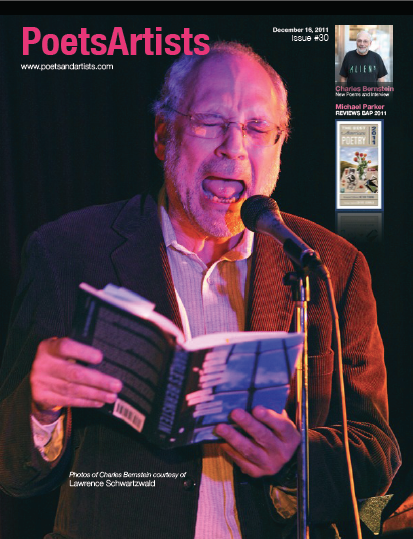
PoetsArtists, issue #30

My interview with Grace Cavalieri, plus 13 new short poems (on pp. 22-38):
Full issue online here.
Print and digital download here.
Easiest to read and download on Scribd
an except from the interview:
What is L=A=N=G=U=A=G=E poetry ?
L=A=N=G=U=A=G=E magazine, which I edited with Bruce Andrews, published its first issue in 1978 and its last in 1982. In our preface to The L=A=N=G=U=A=G=E Book (1984), we provided a summary of our editorial project:
Throughout, we have emphasized a spectrum of writing that places its attention primarily on language and ways of making meaning, that takes for granted neither vocabulary, grammar, process, shape, syntax, program, or subject matter. All of these remain at issue. Focussing on this range of poetic exploration, and on related aesthetic and political concerns, we have tried to open things up beyond correspondence and conversation: to break down some unnecessary self-encapsulation of writers (person from person, & scene from scene), and to develop more fully the latticework of those involved in aesthetically related activity.
At core, L=A=N=G=U=A=G=E was an editorial action: a frame for selecting and combining a range of disparate poetic practices and critical thinking. We didn’t capture an already-existing, fully formed aesthetic as much as participate in its creation. L=A=N=G=U=A=G=E poetry (and its many different names – Language Poetry, Language Poetries, Language Writing, Language-Centered Writing) mark different frames of a field of poetic activity that has no unified stylistic consistency. Indeed, one fraction of this poetic constellation was a resistance to naming, characterization, and standardized modes of representation. So the description is part of the problem and it remains an open question whether this constellation of activity was a movement or school, aesthetic tendency or convenient label, and whether the names for the phenomena were insulting labels or a standard for group solidarity.
L=A=N=G=U=A=G=E was a site of conversation about a set of marked issues, a place to air differences but not necessarily to settle them. That conversation was radically distinct from the values of the official verse culture of the time, and now, not only in terms of what poetry is, what it does, and how it works, but also in terms of the commitment to group and community formation through conversation.
In what ways does this work continue?
L=A=N=G=U=A=G=E and the poetry and poetics surrounding it was formed in controversy and remains controversial because its unity was not a set of agreed upon aesthetic principles, but rather an aversion to the conservative dogmas of much of the dominant poetry of the time. Yet, despite its unruliness, the ensemble of activities that falls under this rubric does share a family resemblance. Both the poetry and poetics posed a stark alternative to the prized poetry of the era.
L=A=N=G=U=A=G=E made a turn from some aspects of modernist avant-garde formations, staying clear of univocal manifestoes, though not from polemic intervention. This is not to say that social or aesthetic insularity, or the promotion of particular styles, was not present, but that it was neither governing nor defining. Indeed, a pervasive wariness about, combined with a peculiar devotion to, some of the more doctrinaire aspects of the modernist avant-garde formations was one of the constituent interests in the formation of the work in and around L=A=N=G=U=A=G=E.
The context provided by L=A=N=G=U=A=G=E remains viable, even as many new poets and new approaches to poetry have emerged: the importance of poetics and of an ideological self-understanding of poetry’s forms and social organization, a questioning of the given and a preference for the chosen, a transvaluation of “the original” toward the found and refashioned, a rejection of the values foisted on poetry by the prize systems and the values of a literary mainstream (a mediocracy) that cares nothing about poetry. What persists is a desire to find the ways and means for expression, affect, thought, ethics, and politics that are not already prescribed by how your supposed to do things: a desire to make feeling, meaning, and rhythm ever more palpable in poems.
read more:
Full issue online here.
Print and digital download here.